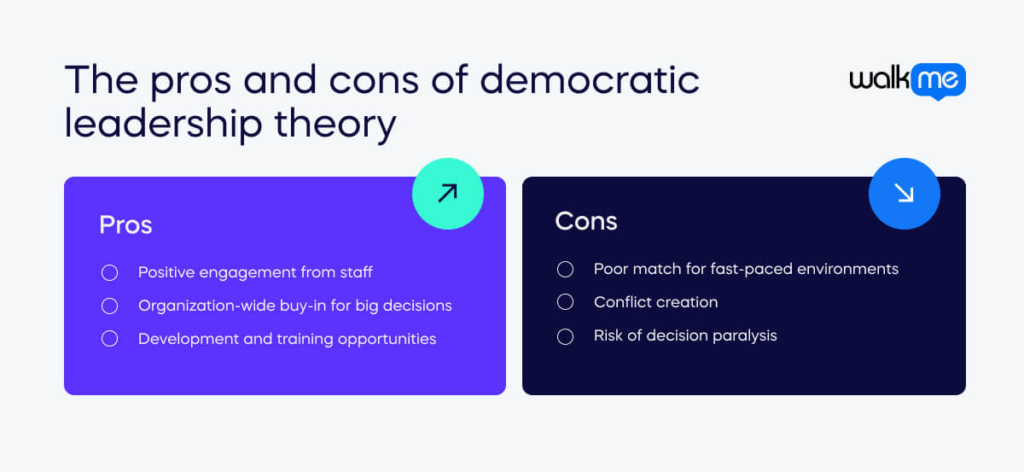Democratic leadership can help organizations make dramatic long-term improvements. By encouraging participation and collaboration, this style supports positive organizational culture, employee engagement, and overall workplace efficiency. It also creates an environment where employees feel empowered to contribute ideas—an essential strength when navigating the complexities of change management.
It’s no surprise that democracy features in many leadership development programs. Still, most organizations cannot operate on true democratic principles. Leaders and managers at all levels must make final decisions, and employees must ultimately follow their direction.
The question, then, is how democratic leadership fits with existing management patterns. In this article, we’ll define democratic leadership, introduce its key features, explore examples of it in practice, and explain both the benefits and the challenges it presents.
As Rebecca Knight noted in a 2024 HBR article, democratic leadership is one of many approaches available to leaders today.
What is democratic leadership?
Democratic leadership can be very simple, but it can also be complex.
Let’s start with the simplest definition. Democratic leadership happens when managers share decision-making tasks with team members. In other words, decision-making is decentralized, devolved, or distributed.
Democratic leaders encourage participation, collaboration, and open communication. They foster a culture of inclusivity and empowerment within the organization. Democratic leadership, sometimes called “participative leadership,” involves the whole team in important aspects of business life.
Why is democratic leadership difficult?
We must acknowledge that “democratic leadership” is more complicated. As two leading scholars said in 2014, “The idea of democratic leadership is inherently paradoxical” (Hendriks and Karsten in The Oxford Handbook of Political Leadership).
Think of it like this: Is anyone a leader if each team member has an equal vote in every decision?
Some organizations operate on truly democratic lines—think of co-operatives, grassroots organizations, and mutual aid operations. However, this approach is almost impossible for large enterprises. Instead, principles of democratic leadership could be applied in various ways.
Here are some convincing arguments about the implementation of democratic leadership:
- Eric Beerbohm (2015) argues that developing a “shared commitment” can channel democracy’s main strengths while enabling teams to work better.
- A classic article on democratic leadership explains it is about “distributing responsibility among the membership, empowering group members, and aiding the group’s decision-making process.” In this sense, leadership qualities are embodied in individual staff members, even if they are not officially managers.
- An article from Robert Starrat proposes sixteen qualities that prove an organization is led democratically. They include participation in governance from all relevant stakeholders and constituencies, voicing objections and frictions, and doing work that benefits the community.
As you can see, many people have commented on the meaning of democratic leadership.
In the rest of this article, we will focus on this theory’s “simple” aspects.
What are the key features of democratic leadership?

How do you know when someone is leading democratically? And if you are already leading democratically, how can you do it more effectively?
Some management styles already encourage people to be strong in these areas. Agile leaders, for example, know very well how to get all their staff involved in the process.
However, there is always room for improvement. This section will introduce three elements that set democratic leaders apart. They are:
Effective soft skills
In democratic leadership, effective soft skills foster collaboration, build trust, and facilitate open communication. For successful democratic leadership, particularly important soft skills include:
Democratic leaders are active listeners. They attentively listen to the perspectives and concerns of team members without judgment. By genuinely listening, leaders support a culture of inclusivity and trust.
Leaders who practice transparency provide clear and honest information about decisions, processes, and goals. They help staff feel informed throughout the decision-making process.
Leaders communicate openly. They clearly articulate goals, expectations, and feedback while encouraging dialogue and collaboration to achieve common objectives.
You might see these soft skills in many different types of leadership. Servant leaders, for example, must be sensitive in all these ways.
Team engagement
In democratic leadership, team engagement is not just a buzzword. It is a fundamental feature of the leadership style. Leaders actively involve team members in decision-making, project planning, and problem-solving tasks.
This level of involvement fosters a sense of ownership and responsibility among team members, leading to higher levels of motivation and commitment.
Team engagement is one of the most valuable aspects of democratic leadership. Democratic Leaders don’t necessarily take a ballot on every decision. However, they create an environment where everyone feels valued and motivated to contribute to the team’s success.
Devolved decision-making
Democratic leadership emphasizes devolved decision-making. Leaders distribute authority across the team rather than centralizing it in one or two people. This inclusive approach empowers every member to actively shape outcomes, fostering collaboration and ownership.
By involving team members in decision-making, democratic leaders unlock diverse perspectives, often leading to more innovative solutions. Additionally, this approach promotes agility, enabling teams to respond swiftly to challenges and opportunities.
Devolved decision-making empowers individuals, fosters collaboration, and maximizes the team’s collective intelligence.
What are some examples of democratic leadership in action?
As we’ve explained, most leaders don’t want to be democratic for every minute of the day. Instead, they will create a positive culture and use explicitly democratic tools at pivotal moments.
Most leaders will find opportunities for these activities at one time or another. In this section, we’ll draw attention to three particularly useful applications of democratic leadership:
Brainstorming sessions
Brainstorming sessions are a prime example of using democracy to improve an organization. In these sessions, everyone’s voice is valued. Each team member has the opportunity to contribute their ideas and insights. Moreover, democratic leadership extends beyond just offering input; it allows everyone to have a say in shaping the outcomes of the process.
While democratic leadership encourages widespread participation, it also recognizes the importance of leadership input to ensure the viability of all options. This combination of inclusivity and guidance often leads to the emergence of truly innovative ideas.
Organizations demonstrate their commitment to their staff by involving employees in brainstorming sessions. It’s an environment that Simon Sinek describes in his highly influential book Start With Why: “Those who lead can do so because those who follow trust that the decisions made at the top have the group’s best interest at heart.
In turn, those who trust work hard because they feel like they are working for something bigger than themselves.” Brainstorming about important business processes is one tool that can help create this positive environment.
Making decisions about project direction
When it comes to making decisions about project directions, democratic leadership proves invaluable for organizations facing multiple viable options. The focus may not be on debating the merits of each idea but on which option is best for a project’s future direction.
However, having multiple options can also introduce the challenge of choosing between them, potentially leaving some team members dissatisfied with the desired direction. Democratic leadership offers a solution by allowing for a fair and transparent decision-making process.
By incorporating democratic tools such as voting or consensus-building, organizations can ensure that every team member has a voice. This reduces the risk of discontent and fosters a sense of ownership and commitment to the chosen path. Ultimately, democratic decision-making helps organizations navigate complex choices while promoting unity and alignment toward shared goals.
Prioritizing tasks in sprint planning meetings
In sprint planning these meetings, teams of experts converge, each possessing valuable insights and perspectives on the tasks at hand. With everyone well-versed in their respective areas, team members naturally want their voices heard.
Democratic leadership ensures that managers hear everyone’s voice during the prioritization process. While the final decision may ultimately rest with leadership, democratic practices ensure the top people acknowledge all possible views.
This approach enhances the quality of decision-making and fosters a sense of trust and collaboration within the team. Democratic leadership in sprint planning meetings promotes cohesion and alignment, driving the team toward successful outcomes.

What are the benefits of democratic leadership theory?
Many of the benefits of good democratic leadership are similar to the positive impacts of any leadership style.
They include employee satisfaction, improving productivity, and appropriate decision-making.
In this section, we’ll focus on the benefits for which democratic leadership is most effective.
Positive engagement from staff
Engaging a team is itself a democratic behavior. So, it should be no surprise that positive engagement is one of the core benefits of democratic leadership, as highlighted in the 2015 leadership research by Amanchukwu, Stanley, and Ololube.
Engagement has many positive knock-on effects. It builds memorable employee experience, fosters collaboration, and enhances productivity, leading to higher retention rates and a more attractive workplace for recruitment. Those impacts won’t come from just one organizational strategy. But democratic leadership can certainly get you started in the right direction.
Organization-wide buy-in for big decisions
Democratic leadership ensures that staff members at every level endorse the big decisions. Decisions are not imposed autocratically from the “top-down.” They come from the ground upwards.
When it’s challenging to determine the objectively “better” decision, having organization-wide buy-in ensures that employees commit to the outcomes. This mitigates staff resistance and makes the journey through complex decisions much easier.
By involving employees in decision-making processes, democratic leaders foster a sense of ownership and commitment, ultimately driving organizational success and effectiveness.
Both high levels and low levels of resistance make life challenging for leaders. Buy-in from staff of every kind will quickly make transitions easier.
Development and training opportunities
In democratic environments where decentralized decision-making is practiced, employees routinely engage in problem-solving and decision-making processes in lower-risk settings.
This hands-on experience is a form of “on-the-job” training, allowing staff to hone their decision-making skills and gain valuable experience that enhances their capabilities.
By actively participating in decision-making processes, employees develop their skills and feel more empowered and engaged in their roles, leading to increased job satisfaction and performance.
What are the challenges of democratic leadership theory?
In theory, democratic leadership sounds wonderful. After all, doesn’t everyone want to make their team feel valued and invested in their work?
However, there are challenges for democratic leadership in the workplace. Democratic approaches can have the complete opposite impact compared to what was intended.
In this section, we’ll take a look at three key challenges:
Poor match for fast-paced environments
In some teams, quick decisions are crucial for project outcomes. In these environments, democratic leadership won’t be the best approach. Simply put, the time required for consensus-building can be impractical when stakeholders need rapid responses.
As a result, democratic leadership may struggle to keep pace with the dynamic nature of fast-moving industries or projects. In turn, democratic processes could hinder the organization’s ability to adapt and thrive.
Unfortunately, this is a problem even for workplaces with occasional time-dependent demands. For those moments, your managers will need to use alternative leadership styles.
Conflict creation
Despite its intentions, democratic leadership can accidentally create conflicts within teams. When multiple voices contribute to decision-making processes, disagreements will inevitably arise from time to time. While healthy debate can be productive, it may escalate into conflicts if not managed effectively.
Conflict can have a deeply negative effect on your team’s morale, productivity, and cohesion.
In 2024, Gartner’s Future of Work trends report recognized that inter-employee conflict was one of the key trends that needed managing. There are lots of strategies to reduce organizational conflict.
But the best method is to avoid it in the first place. Leaders must be ready to handle different views and diffuse moments of tension as soon as they arise.
Risk of decision paralysis
In democratic settings, where consensus-building and input from multiple stakeholders are valued, reaching an agreement on key decisions may take considerable time and effort. Some leaders may want to get a unanimous decision.
It’s a noble goal. However, it can also prolong the decision-making process excessively.
Delays in decision-making can impede progress, hinder productivity, and lead to missed opportunities. Therefore, while democratic leadership promotes inclusivity and empowerment, leaders must be mindful of balancing participatory decision-making with the need for timely action to avoid the risk of decision paralysis.
What does democratic leadership mean today?
“Democratic leadership” indicates a set of tools and competencies that any leader can use to improve their team’s performance. This is not a buzzword for the moment.
But, democratic principles are at work in many leading works of leadership theory.
For example, Matt Mayberry’s 2023 book Culture is the Way does not prioritize democratic structures. But look at what he says about the employee feedback loop:
“Continuous conversations between leaders and employees are essential for keeping them on track and feeling supported. How can leaders influence and change mindsets if they don’t know what their employees think?”
Conversation, feedback, and discussion are fundamentally democratic, even if a leader has the final say.
Today’s leaders should hone their democratic toolkit to discover many high-impact benefits.


